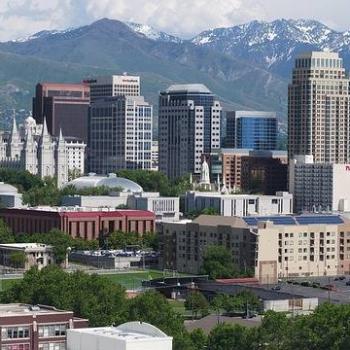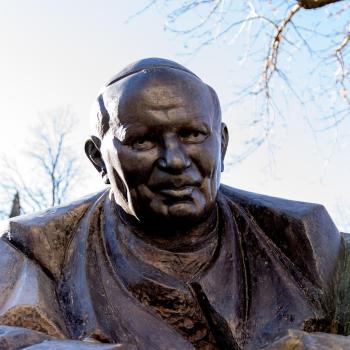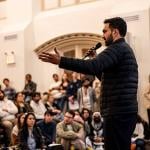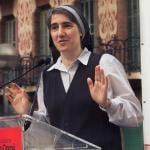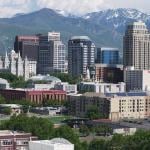THE QUESTION:
Whatever happened to U.S. “Mainline” Protestantism over the past half-century?
THE RELIGION GUY’S ANSWER:
What’s known as “Mainline” Protestantism was pretty much America’s culture-defining faith till well after World War Two. Fifty years ago, these church groups still maintained high morale and together boasted at least 28 million members. But by the latest available statistics they’ve shrunk 45%, to 15.5 million. During those same decades, the U.S. population increased 61%.
Across U.S. religious history, nothing like this has been seen before. What happened?
We’re talking about several small denominations alongside the larger and roughly similar “seven sisters” — American Baptist Churches USA, Christian Church (Disciples of Christ), Episcopal Church, Evangelical Lutheran Church in America, Presbyterian Church (USA), United Church of Christ, and the largest, the United Methodist Church.
The Religion Guy recently culled his basement library and came across two remarkably prescient books from a half-century ago, “The Gathering Storm in the Churches” (1969) by sociologist Jeffrey K. Hadden at Case Western Reserve University (and later the University of Virginia), and “Why Conservative Churches Are Growing” (1972) by the Rev. Dean M. Kelley, director for civil and religious liberty at the National Council of Churches (NCC).
Mainline groups share several key traits: predominantly white memberships, origin in Colonial times through the early 19th Century, ecumenical affiliations with the NCC and World Council of Churches, and pluralism that tolerates liberal religious thinking in contrast with the strictly conservative white “evangelical” Protestants. (Black Protestants often share evangelical traits but embrace a distinct subculture.)
Hadden’s book reported on his pioneering survey of 7,441 pastors in five Mainline Protestant groups (plus the conservative Lutheran Church—Missouri Synod), and incorporated survey data on lay Protestants in California as reported in 1968 by Rodney Stark and Charles Glock.
He said churches faced a dangerous and “widening gap” between lay members and clergy who were pursuing civil-rights activism (Viet Nam protests emerged later) and downplaying or shedding traditional religious beliefs. For example, only 49 percent of the Methodist clergy believed in “Jesus’ physical resurrection as an objective historical fact.”
Clergy revisionism on doctrine was strongly associated with devotion to liberal politics, but not so with lay members. Clergy did not mostly suffer hostility from members over their liberal views as such, Hadden explained. Rather, the problem was that the typical lay member “seeks comfort and escape from the world in the sanctuary of God” and doesn’t understand why ministers do not focus concern on their own congregations.
Thus, Mainline clergy were on a “collision course” with their parishioners amid a multi-layered crisis. “Serious doubt about the most basic theological doctrines of Christianity” arose alongside “a growing struggle over the meaning and purpose of the church,” which caused a “crisis of authority.”
Enter Methodist Kelley, whose book got special buzz because the NCC where he worked was then a pivotal Mainline institution. He sensed correctly that slight membership losses the past few years were not merely a blip but anticipated a bleak Mainline future.
The Kelly theory is sometimes misunderstood. He was not talking about growth by political conservatives. In that era, social activism was emphasized in liberal churches. Nor did Kelley oppose social activism or demand orthodox theology. But he concluded that politics was crowding out what Christianity was about and what people needed and looked for. And churches that were conservative in belief tended to have traits that produced successful ministries.
To Kelley, people seek “meaning” in their lives that only religion can provide. Each individual tries to make sense out of life experience, the purpose of our existence, “the nature of reality, the fate of the world, the character of the forces that determine his destiny and how he can relate to them.” Also, “how can I survive” or “why do bad things happen?” These “largest patterns of meaning are the subject matter of religion,” and churches succeed when they “are explaining life to their members so that it makes sense to them.”
In sum, churches falter if they lack ideas that “explain things convincingly” and have “the power to change lives.” In theory, this can be offered by theologically liberal churches. In practice, it often is not. And mobilization for social activism will generally be weak unless it is clearly an outgrowth of these prior ultimate convictions, he argued.
In Kelly’s view, traditional doctrines should not be cast aside without a coherent substitute, which proves difficult. Yet specific beliefs are less significant for success than “the demands made upon would-be members and the commitment with which they respond.” The “placid and circumspect” Mainline congregations do not usually “think of religion as a strenuous and fateful adventure” laden with “significance and purpose.”
A church prospers through “high commitment to its goals or beliefs” whatever they are, he argued. That means absolutism and conformity on belief as opposed to relativism and openness to dissent. In addition, churches need a “badge of belonging” — distinct beliefs or practices that increase their “social strength.” Think John Wesley’s original Methodists or the Latter-day Saints.
In his summation, the incentives to join liberal churches are things like fellowship, entertainment, knowledge, and respectability, which are readily available from many non-religious organizations. Conservative churches offer something that “is not as widely available – salvation – and offer it persistently.” Their only competition comes from other conservative churches.
Some conservative and evangelical Protestants recently began to suffer losses as secularism gained power. And some evangelicals have climbed aboard the partisan conservative bandwagon, though new new research shows their local churches are still less politicized than those of Mainline and Black Protestants and Catholics. See https://www.getreligion.org/getreligion/2020/9/21/evangelicals-are-actually-americasleastpoliticized-group-of-churches The Religion Guy suggests that when the Trump Era concludes, whether in 2021 or 2025, those U.S. evangelical pastors who’ve become immersed in politics might ponder Kelley’s advice from 1972.




